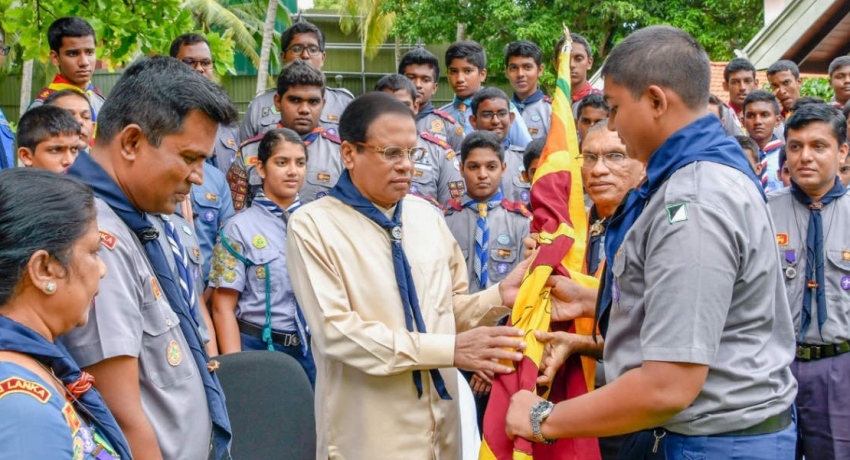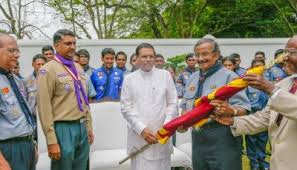A CHIEF SCOUT OF CEYLON (ලංකාවේ ප්රධාන බාලදක්ෂයා)
The Governor, appointed by the
British monarch (on the advice of the prime minister), maintained executive power in Ceylon throughout British rule. He was head of the executive council and the pre-independence government of Ceylon. The Governor was the most powerful official in Ceylon, except only during World War II, when Admiral Sir Geoffrey Layton was appointed Commander-in-Chief, Ceylon with power exceeding that of the Governor. The Governor was the
ex-officio Chancellor of the
University of Ceylon.
 |
Governors of British Ceylon
|
The
Governor-General of Ceylon was the representative of the Ceylonese monarch and head of state, who held the title of King or Queen of Ceylon (as of 1952, Queen Elizabeth II) from 1948 when the country became independent as a Dominion until it became the republic of Sri Lanka in 1972.
.svg.png) |
| Governor-General of Ceylon |
Sir Henry Edward McCallum 24 Aug 1907 - 24 Jan 1913
Reginald Edward Stubbs (1st time) 24 Jan 1913 - 18 Oct 1913
Robert Chalmers 18 Oct 1913 - 4 Dec 1915
Reginald Edward Stubbs (2nd time) 4 Dec 1915 - 15 Apr 1916
Sir John Anderson 15 Apr 1916 - 24 Mar 1918
Reginald Edward Stubbs (3rd time) 24 Mar 1918 - 10 Sep 1918
Sir William Henry Manning 10 Sep 1918 - 1 Apr 1925
Cecil Clementi (acting) 1 Apr 1925 - 18 Oct 1925
Edward Bruce Alexander (acting) 18 Oct 1925 - 30 Nov 1925
Sir Hugh Clifford (2nd time) 30 Nov 1925 - Jun 1927
Arthur George Murchison Fletcher Jun 1927 - 20 Aug 1928
Sir Herbert James Stanley 20 Aug 1928 - 11 Feb 1931
Bernard Henry Bourdillon (acting) 11 Feb 1931 - 11 Apr 1931
Sir Graeme Thomson 11 Apr 1931 - 20 Sep 1933
Francis Graeme Tyrrell (acting) 20 Sep 1933 - 23 Dec 1933
Reginald Edward Stubbs (4th time) 23 Dec 1933 - 30 Jun 1937
Maxwell MacLagan Wedderburn 30 Jun 1937 - 16 Oct 1937
Sir Andrew Caldecott 16 Oct 1937 - 19 Sep 1944
Henry Monck-Mason Moore 19 September 1944 - 4 February 1948
A CHIEF SCOUT OF SRI LANKA (ශ්රී ලංකාවේ ප්රධාන බාලදක්ෂයා)
The President is elected by the people and holds office for a period of
six years. The President has the right to attend, address and send
messages to Parliament at any time. The President is also entitled to
all the privileges, immunities and powers of a Member of Parliament
other than the right to vote, and shall not be liable for any breach of
the privileges of Parliament, or of its Members.
The President is the Head of the Cabinet of Ministers, presides at
meeting of the Cabinet and appoints the Prime Minister from among the
members elected to Parliament. The powers of the President include that of summoning, proroguing and
dissolving Parliament and calling for a Referendum, in keeping with the
relevant provisions of law.
The President is the Patron and Chief Scout, (Ceylon Scout Council Act. - This Act may be cited as the Ceylon Scout Council (Incorporation) Act, No. 13 of 1957)) It seems that each Sri Lankan President had to be a Chief Scout in Sri Lanka. Every Sri Lankan President's has his own flag. From the
rulers of the list of presidents is the Republic (1978-2000 Democratic Socialist Republic)
List of Chief Scout in Sri Lanka
- William Gopallawa 22 May 1972 - 4 Feb 1978
- Junius Richard Jayawardene 4 Feb 1978 - 2 Jan 1989
- Ranasinghe Premadasa 2 Jan 1989 - 1 May 1993
- Dingiri Banda Wijetunge 2 May 1993 - 12 Nov 1994
- Chandrika Kumaratunga 12 Nov 1994 - 19 Nov 2005
- Mahinda Rajapaksa 19 Nov 2005 - 9 January 2015
- Maithripala Sirisena 9 January 2015 - 18 November 2019
- Lt.Co Gotabaya Rajapaksa18 November 2019 -
The British Governor of Ceylon was an official who ruled British Ceylon during the British colonial period between 1798 and 1948. Upon the end of British rule and the creation of Dominion of Ceylon in 1948, this office was replaced by the Governor-General, who represented the British Monarch
and not the Government of the United Kingdom as did the Governor. The
office of Governor-General was itself abolished in 1972 and replaced by
the post of President when Sri Lanka became a Republic.
 |
Sri Lanka Governor General
Sir Oliver Ernest Goonetilleke, GCMG, KCVO, KBE |
 |
William Gopallawa
Last Governor-General of the Dominion of Ceylon / Executive
President |
Therefore the presidential flag
is somewhat of a logical analog. Blue with the national coat of
arms in full colours above a white bordered red inscription (reading Sri Lanka, some lectures in Sinhalese).
 |
J.R.Jayawardene
President of the Democratic Socialist Republic of Sri Lanka
|
The red and green colours are for prosperity and
progress. The central device is the Dhammachakka wheel, representing justice in
society. The eight-spoked wheel refers to the noble eight fold path of Buddhism
(right understanding, right thoughts, right speech, right behaviour, right
livelihood, right effort, right mindfulness and right concentration). The corner
ornaments are the Sinhalese word "Jaya" (Victory). The proportions are
(according to the text) 2:3, even if the image pictured is 1:2. The central
device is 3/5 the width of the flag. The word Jaya is also the first two
syllables of the president's name (J. R. Jayawardene). Colours of the corner
devices and the central emblem are not given. The same flag (ratio 1:2), is
pictured in Flaggenmitteilung 65, showing the corners ornaments green and the
central wheel yellow.
 |
Ranasinghe Premadasa
President of the Democratic Socialist Republic of Sri Lanka
|
Red with a stylized lotus flower; a
border of white and green decorated with gold rice leaves; in each corner "bo"
leaves". This might be Premadasa's flag, therefore the Sri Lankan presidential
standard 1989-1993. It shows analogies both to the current flag (lotus flower,
bo leaves) and to the previous one (green-white border). The central emblem is a disk with ornaments very
different from that shown in Album des Pavillons (2000). It looks like a flower
or an image seen in a kaleidoscope.
 |
Chandrika Kumaratunga
President of the Democratic Socialist Republic of Sri Lanka |
Yellow flag with red-white-red unequal border and four white pipul leaves,
one in each corner. In the middle there is a red white and yellow rosette
(arabesque, if you like, though probably this is not proper word here). [Red
here is the brownish red of the national flag.] It seems that in all these representations
of the presidential flag it is not in ratio 1:2, but (very) close to 4:9. he ratio is 4:9. The patterned border ornament is still not known as we lack
a precise original picture.
.gif) |
Mahinda Rajapaksa
President of the Democratic Socialist Republic of Sri Lanka |
The flag has a maroon or burgundy field, a yellow ornamental border, the 4
inward-pointing yellow leaves which are also on the main portion of the national
flag, and a yellow circular device in the center. The number of florets in the border is conjectural, as no entire side is
visible.
 |
Honourable Maithripala Sirisena
President of the Democratic Socialist Republic of Sri Lanka |
A white lotus has been used as the main theme of the flag and it depicts
the pure governance of the President. Fame and glory have been depicted
from the four-sided filaments that extend from the stigma of the white
lotus. Wisdom and honesty have been depicted by the white and yellow circles
around the lotus. Buddhism and the influence it has had on the nation
has been depicted by the Bo Leaves on the four corners. Necessary
factors for happiness; Uttana Sampadha, Arakka Sampadha, Kalyana
Miththa, and Samajeevatha have also been depicted by the Bo leaves.
 |
Honourable Gotabaya Rajapaksa
President of the Democratic Socialist Republic of Sri Lanka |
Officially Handing over Ceremonys the National flag of Sri Lanka
 |
| SL flag officially handed over to World Scout Jamboree delegation |
 |
| Add caption |
Handing over the national flag of Sri Lanka officially to the delegation from Sri Lanka to the World Scouts Jamborees. The President, while congratulating the Sri Lankan delegation pointed
out the importance of taking the identity of Sri Lanka to the world.






.svg.png)





.gif)











